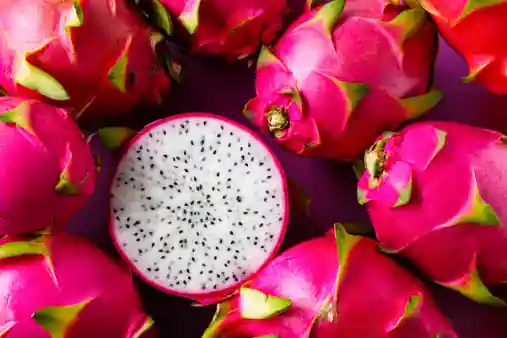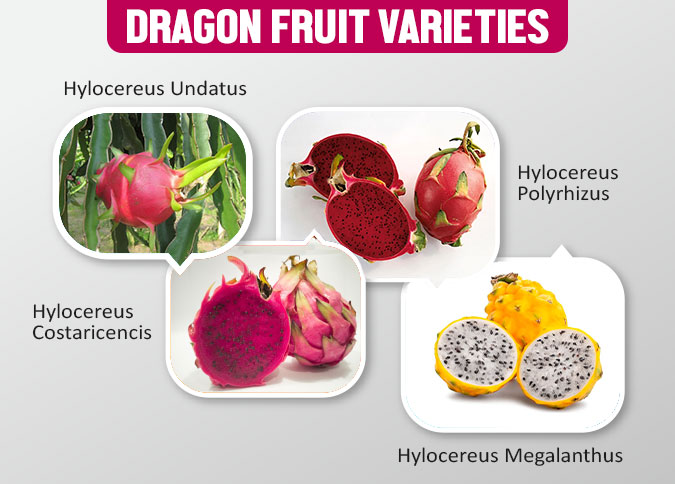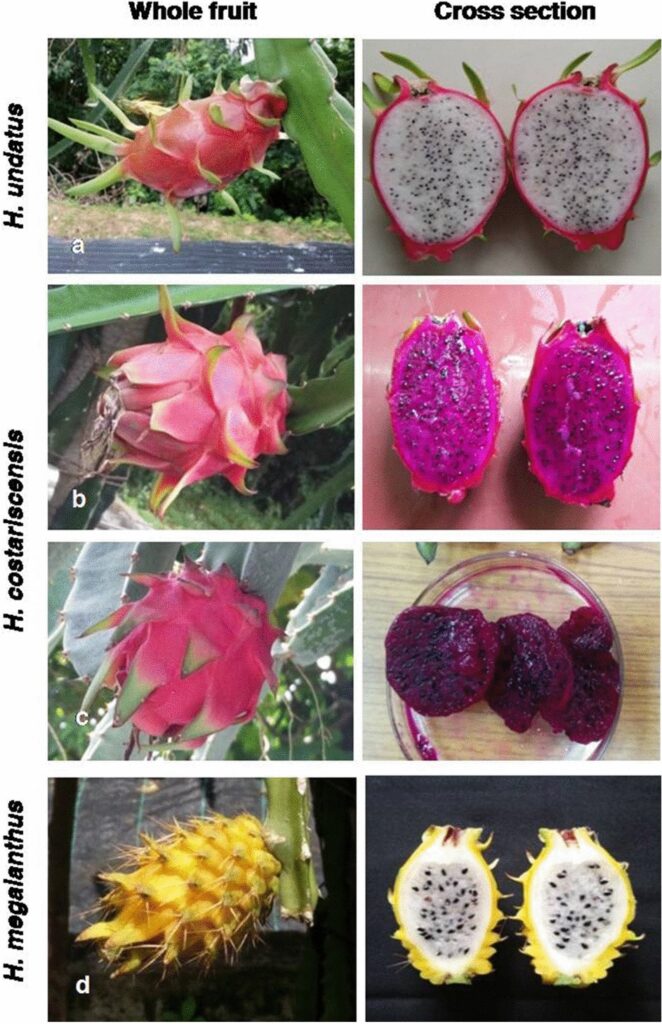There are several dragon fruit types, each with its unique characteristics, including differences in skin color, flesh color, and taste. The two main species of dragon fruit are Hylocereus undatus and Hylocereus costaricensis.
Here are some common dragon fruit types:

- Hylocereus Undatus (White-Fleshed Dragon Fruit):
- Exterior: Pink or yellow skin with green scales.
- Flesh: White with small black seeds.
- Flavor: Mild and slightly sweet.
- Hylocereus Costaricensis (Red-Fleshed Dragon Fruit):
- Exterior: Pink or yellow skin with red or pink scales.
- Flesh: Vibrant red or pink with small black seeds.
- Flavor: Sweet with subtle floral notes.
- Hylocereus Megalanthus (Yellow Dragon Fruit):
- Exterior: Yellow skin with green scales.
- Flesh: White with small black seeds.
- Flavor: Sweet and mildly tangy.
- Selenicereus Undatus (Vietnamese Jaina):
- Exterior: Pink or yellow skin with large, distinct scales.
- Flesh: White with small black seeds.
- Flavor: Mild and sweet.
- Hylocereus Polyrhizus (Vietnamese Dragon Fruit):
- Exterior: Red skin with green scales.
- Flesh: Red or pink with small black seeds.
- Flavor: Sweet with a hint of acidity.
- Hylocereus Ocamponis (Costa Rican Sunset):
- Exterior: Yellow skin with reddish-pink scales.
- Flesh: Red with small black seeds.
- Flavor: Sweet and juicy.
- Hylocereus Megalanthus X Hylocereus Undatus (Physical Graffiti):
- Exterior: Pink or purple skin with green scales.
- Flesh: Deep magenta with small black seeds.
- Flavor: Sweet with a unique combination of tropical flavors.
- Hylocereus Polyrhizus X Hylocereus Undatus (American Beauty):
- Exterior: Red skin with green scales.
- Flesh: Magenta with small black seeds.
- Flavor: Sweet with a rich taste.
It’s important to note that these are just a few examples, and there are many hybrid varieties and local cultivars with distinct characteristics. The taste and appearance can also vary based on factors such as growing conditions, ripeness, and individual preferences

Hylocereus Undatus (White-Fleshed Dragon Fruit):
Hylocereus Undatus, commonly known as White-Fleshed Dragon Fruit or Pitaya Blanca, is one of the most popular and widely cultivated varieties of dragon fruit. Here are some specific details about this type:
Exterior:
The skin of Hylocereus Undatus is typically pink or yellow and is covered in green, leaf-like scales. The scales can vary in size and shape, giving the fruit a unique appearance.
Flesh:
The flesh of this variety is white, and it contains numerous small, black seeds distributed throughout the fruit. The seeds are edible but are often considered a bit crunchy.
Flavor:
The flavor of the white-fleshed dragon fruit is mild and slightly sweet. It has a refreshing taste with subtle floral notes. The sweetness may vary depending on factors such as ripeness and growing conditions.
Texture:
The texture of the flesh is often compared to that of kiwi. It is juicy and has a somewhat grainy or crunchy texture due to the presence of seeds.
Nutritional Content:
White-fleshed dragon fruit is rich in nutrients, including vitamin C, B vitamins, fiber, antioxidants, and minerals. Despite being relatively low in calories, it offers various health benefits.
Growing Conditions:
Hylocereus Undatus is a tropical and subtropical cactus that thrives in warm climates. It requires well-draining soil and can be cultivated in areas with sandy or loamy soil. The plant is known for its large, night-blooming flowers, which develop into the distinctive dragon fruit.
Cultivation:
Dragon fruit is cultivated in various countries, and its cultivation has expanded globally due to its popularity. It can be grown both commercially and in home gardens, provided the right climate conditions are met.
Versatility:
White-fleshed dragon fruit is versatile and can be enjoyed on its own or added to fruit salads, smoothies, or desserts. Some people also use the fruit in savory dishes or as a garnish.
Overall, Hylocereus Undatus is prized not only for its visual appeal but also for its mild and enjoyable flavor, making it a popular choice among dragon fruit enthusiasts.

Hylocereus Costaricensis (Red-Fleshed Dragon Fruit):
Hylocereus Costaricensis, commonly known as Red-Fleshed Dragon Fruit or Costa Rican Pitaya, is another popular variety of dragon fruit with distinct characteristics. Here are some details about this type:
Exterior:
The skin of Hylocereus Costaricensis is typically pink or yellow, and it is covered in bright, eye-catching scales. The scales can vary in size and shape, giving the fruit a visually appealing appearance.
Flesh:
The flesh of this variety is vibrant red or pink, creating a striking color contrast with the outer skin. Similar to other dragon fruit varieties, it contains small, black seeds distributed throughout the flesh.
Flavor:
The red-fleshed dragon fruit is known for its sweet flavor with subtle floral notes. The sweetness level may vary based on factors such as ripeness and growing conditions, but it is generally considered pleasantly sweet.
Texture:
The texture of the flesh is juicy and can be compared to that of kiwi. The presence of seeds adds a bit of crunchiness to the overall texture.
Nutritional Content:
Red-fleshed dragon fruit is rich in nutrients, including vitamin C, B vitamins, fiber, antioxidants, and minerals. It shares nutritional benefits with other dragon fruit varieties.
Growing Conditions:
Hylocereus Costaricensis, like other dragon fruit varieties, is a tropical and subtropical cactus that thrives in warm climates. It requires well-draining soil and is often grown in areas with sandy or loamy soil. The plant is known for its large, night-blooming flowers that develop into the distinctive red-fleshed dragon fruit.
Cultivation:
This variety is cultivated in various regions with suitable climates. Commercial cultivation has expanded globally due to the increasing demand for dragon fruit. It can be grown in both tropical and subtropical regions.
Versatility:
Red-fleshed dragon fruit is versatile and can be enjoyed on its own, added to fruit salads, used in smoothies, or incorporated into desserts. Some people also use the fruit in culinary dishes for both its flavor and visual appeal.
The vibrant color and sweet taste of the red-fleshed dragon fruit make it a popular choice among consumers, and it is often sought after for its aesthetic appeal in addition to its nutritional benefits
